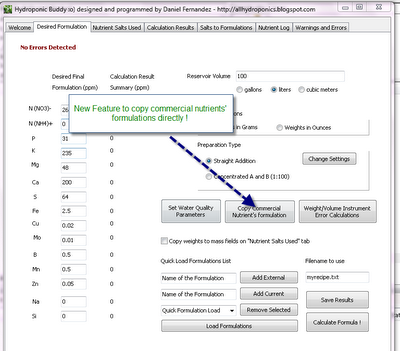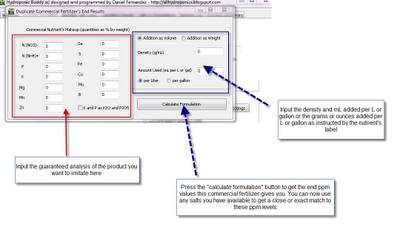–
 –
–This new feature – as shown above- is accessible through a button in the “Desired Formulation” tab. This button is located between the water quality and instrument precision buttons, just below the “preparation type” dialogue box. When this button is clicked a new window pops up in which the user can input the percentage composition of the commercial fertilizer he/she wishes to imitate as well as the manner in which this commercial fertilizer is supposed to be added in order to arrive at the final concentrations intended by the manufacturer.
For liquid fertilizers the maker usually gives you a volume measure to add per gallon or liter which should be expressed as mL per gallon or liter (you can choose if you want to specify the quantity added per gallon or liter using the radio buttons for this purpose). In the case of solid fertilizers the label usually tells you to add a given number of grams or ounces per liter or gallon. You can choose between specifying a given volume and density or a given weight by using the “Addition as weight” or “Addition as volume” radio buttons located at the top right of the new window.
Once you input these parameters you are now ready to get the intended end result for this commercial fertilizer by using the “Calculate Formulation” button. When you click this button the program will automatically calculate the end concentrations which result from adding the amount of the commercial nutrients you specified with the composition you also specified. These values are automatically copied to the “Desired Final Formulation” column and they can now be used to imitate the commercial formulation. You can now select a given number of salts you have available and use the regular preparation types in order to come up with a direct addition or 1:100 concentrated solution which will match up the end concentration results achieved with the commercial fertilizer you input.
– –
–
Of course, this will NOT guarantee a perfect copy of the commercial fertilizer since many of the ingredients a commercial fertilizer may contain may not be listed or they can be listed but their actual concentration levels may not be specified. For example you will find that many commercial nutrients contain Boron but their guaranteed analysis does not show it. This is mainly because the law does not require them to include boron in their analysis and therefore they will add it but they will not disclose its actual concentration or sometimes even its presence. Several other additives or nutrients may receive similar treatment so for this reason it is always good to make up A and B concentrated solutions or direct additions which include ALL elements necessary for plant growth.
Do you find this feature useful ? Is there any feature that you would like to see implemented in hydrobuddy ? Feel free to leave a comment with any opinion or suggestion you may have :o)




